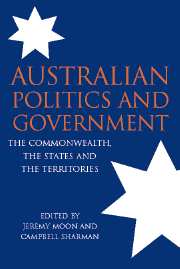Book contents
- Frontmatter
- Contents
- List of contributors
- List of figures and tables
- Acknowledgements
- 1 Introduction
- 2 The Commonwealth
- 3 New South Wales
- 4 Queensland
- 5 South Australia
- 6 Tasmania
- 7 Victoria
- 8 Western Australia
- 9 Australian Capital Territory
- 10 Northern Territory
- 11 One System or Nine?
- Note on Sources and Links to the Web
- Notes
- Appendix: Periods in Office
- References
- Index
10 - Northern Territory
Published online by Cambridge University Press: 05 September 2012
- Frontmatter
- Contents
- List of contributors
- List of figures and tables
- Acknowledgements
- 1 Introduction
- 2 The Commonwealth
- 3 New South Wales
- 4 Queensland
- 5 South Australia
- 6 Tasmania
- 7 Victoria
- 8 Western Australia
- 9 Australian Capital Territory
- 10 Northern Territory
- 11 One System or Nine?
- Note on Sources and Links to the Web
- Notes
- Appendix: Periods in Office
- References
- Index
Summary
The process of the constitutional development of the Northern Territory as a separate political entity began in 1863, when the Colonial Office of Great Britain vested control of the Northern Territory in the government of South Australia. In 1888 the South Australian government constituted the territory as a single, two-member electoral district for the South Australia House of Assembly, and with representation in the Legislative Council. By 1902 the South Australian government felt that the territory was too great a drain on the finances of the state and, after nine years of negotiation, the Commonwealth took over the administration of the Northern Territory.
For the next thirty-six years, from 1911 to 1947, the Northern Territory was governed directly by the Commonwealth, under the control of the Minister for External Affairs – a situation which did not please Territorians. Local authority was exercised by an administrator who acted on instructions from the Commonwealth. Territorians had no representative participation in their own affairs. In 1931 the Scullin Labor government introduced a bill for an ordinance-making Legislative Council for the territory, equivalent to the Councils in the colonies in the period 1850 to 1857. But even this minor reform was rejected by the Liberal–Country majority in the Senate, partly because the only political organization in the territory at the time was Labor.
- Type
- Chapter
- Information
- Australian Politics and GovernmentThe Commonwealth, the States and the Territories, pp. 224 - 238Publisher: Cambridge University PressPrint publication year: 2003



